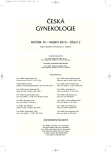Significance of hysteroscopic resection in diagnostics of endometrial cancer
Authors:
M. Dvorská 1; Daniel Driák 1
; I. Švandová 3; B. Sehnal 1; P. Holý 1; K. Benková 2; Z. Špůrková 2; M. Halaška 1
Authors place of work:
Gynekologicko-porodnická klinika, 1. LF UK a FN Na Bulovce, Praha
1; Oddělení patologie, FN Na Bulovce, Praha
2; Katedra fyziologie živočichů, Přírodovědecká fakulta, Univerzita Karlova, Praha
3
Published in the journal:
Ceska Gynekol 2010; 75(2): 105-108
Summary
Objectives:
Endometrial cancer is the second most common malignancy of the female genital tract. Its incidence in the Czech Republic is 32/100 000 women and year with a permanent increasing tendency. In comparison with incidence, its mortality remains relatively low, with mortality ratio of 6.7 per 100 000 women and year. The decrease in mortality might be explained predominantly by early diagnostics. The most controversial issue is the potential risk of microscopic extrauterine dissemination of cancerous cells within the peritoneal cavity and circulation during hysteroscopy, and the question if the relatively high pressure of distension medium used during hysteroscopies may or may not multiply the risk.
Design:
Retrospective study.
Materials and methods:
Totally, 400 endometrial biopsies were collected during years 2007-2009 at our clinic. In 56 patients, endometrial cancer was diagnosed. Afterwards, 44 women underwent surgery, during which peritoneal washing (lavage) and cytological examination were done.
Results:
Fifty-six patients with histologically verified endometrial carcinoma were studied. The samples examined in the study were classified by grading as follows: G1 n=34, G1-2 n=10, G2 n=10, G3-4 n=2. In 44 cases that underwent radical surgery, no cancerous cells in peritoneal washings were found. Only in 1 case, the cytology obtained from peritoneal washing was considered to be suspicious. In 9 cases, carcinoma on the base of the polyp was detected, and in 2 cases, no residuum of cancer was observed after hysterectomy.
Conclusion:
In accordance with contemporary literature and based on our study, we suggest that hystero-resectoscopy does not increase the risk of dissemination of malignant cells within the peritoneal cavity and does not worsen the prognosis of the disease. On the contrary, the samples taken under visual control provide more precise and earlier diagnostics of endometrial cancer.
Key words:
endometrial cancer, dilatation, curretage, hysteroscopy.
Zdroje
1. Bijen, C., de Bock, G., ten Hoor, K., et al. Role of endocervical curettage in the preoperative staging of endometrial carcinoma. Gynec Oncol 2009, 112, p.521-525.
2. Cibula, D., Petruželka, L., a kol. Onkogynekologie. Praha: Grada Publishing, 2009.
3. Cravello, L., Stolla, V., Bretelle, F., et al. Hysteroscopic resection of endometrial polyps: a study of 195 cases, Eur J Obst Gynecol Reprod Biol 2000, 93, p. 131-134.
4. Gutman, G., Almong, N., Lessing, J., et al. Diagnosis of endometrial cancer by hysteroscopy does not increase the risk for microscopic extrauterine spread in early-stage disease. Gynecol Surg 2005, p. 21-23.
5. Kudela, M., Pilka, R., Dzvincuk, P., a kol. Risks in hysteroscopy in patients with endometrial carcinoma. Čes Gynek 2002, 67, s. 74-78.
6. Mara, M., Fucikova, Z., Kuzel, D., et al. Hysteroscopy after uterine fibroid embolization in women of fertile age. 2007, 33, p. 316-324.
7. Obermair, A., et al. Does hysteroscopy facilitate tumor cell dissemination? Cancer 2000, 88, p.139-143.
8. Sharma, M., Taylor, A., Magos, A., et al. Management of endometrial polyps: a clinical review. Rev Gyn Practice 2004, 4, p. 1-6.
9. Shushan, A., Revel, A., Lafer, N., et al. Hysteroscopic treatment of intrauterine lesions in pre - and postmenopausal women. J Am Assoc Gynecol Laparosc 2002, 9, p. 209-213.
10. Solima, E., Brusati, V., Ditto, A., et al. Hysteroscopy in endometrial cancer: new methods to evaluate transtubal leakage of saline distension medium. Am J Obstet Gynecol 2008, 198, p. 241.e1-214.e4.
Štítky
Detská gynekológia Gynekológia a pôrodníctvo Reprodukčná medicínaČlánok vyšiel v časopise
Česká gynekologie

2010 Číslo 2
- Ne každé mimoděložní těhotenství musí končit salpingektomií
- I „pouhé“ doporučení znamená velkou pomoc. Nasměrujte své pacienty pod křídla Dobrých andělů
- Gynekologické potíže pomáhá účinně zvládat benzydamin
- Mýty a fakta ohledně doporučení v těhotenství
- Jak podpořit využití železa organismem bez nežádoucích účinků
Najčítanejšie v tomto čísle
- Současné možnosti diagnostiky vulvovaginálních infekcí
- Doporučení pro hormonální substituční terapii v postmenopauze
- Význam resektoskopie v diagnostice karcinomu endometria
- První zkušenosti s novou minipáskou k léčbě stresové inkontinence moči u žen – MiniArc
